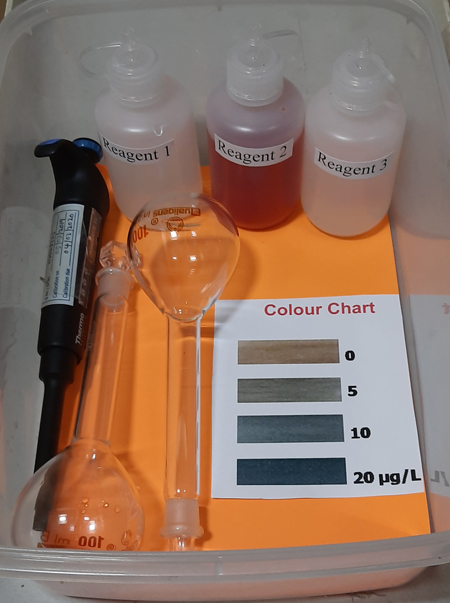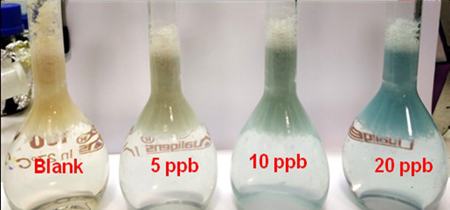

Aluminium (Al) is potentially neurotoxic due to its indiscriminate binding with various ligands (phosphate, citrate; proteins-transferrin, catecholamine). Al can cross blood brain barrier and accumulate in brain leading to memory impairment, cognitive dysfunction, neurodegenerative disorders (Parkinson's and Alzheimer's) etc. The toxic effect of Al is of concern in chronic renal failure patients on dialysis and patients receiving long term parenteral nutrition. Therefore, an accurate control of Al in commercial dialysis solutions is necessary (must be lower than 10 µg/L for dialysis fluids and 200 µg/L in drinking water) to determine its suitability. Aluminium Visual Detection Kit (AVDK) is useful for the detection of Al in peritoneal dialysis fluids and ground waters. Using this kit, the test samples can be immediately categorized as safe, permissible or toxic for their suitability with respect to aluminum.
Aluminium (Al) is potentially neurotoxic due to its indiscriminate binding with various ligands (phosphate, citrate; proteins-transferrin, catecholamine). Al can cross blood brain barrier and accumulate in brain leading to memory impairment, cognitive dysfunction, neurodegenerative disorders (Parkinson's and Alzheimer's) etc. The toxic effect of Al is of concern in chronic renal failure patients on dialysis and patients receiving long term parenteral nutrition. Therefore, an accurate control of Al in commercial dialysis solutions is necessary (must be lower than 10 µg/L for dialysis fluids and 200 µg/L in drinking water) to determine its suitability. Aluminium Visual Detection Kit (AVDK) is useful for the detection of Al in peritoneal dialysis fluids and ground waters. Using this kit, the test samples can be immediately categorized as safe, permissible or toxic for their suitability with respect to aluminum.
Aluminium (Al) is potentially neurotoxic due to its indiscriminate binding with various ligands (phosphate, citrate; proteins-transferrin, catecholamine). Al can cross blood brain barrier and accumulate in brain leading to memory impairment, cognitive dysfunction, neurodegenerative disorders (Parkinson's and Alzheimer's) etc. The toxic effect of Al is of concern in chronic renal failure patients on dialysis and patients receiving long term parenteral nutrition. Therefore, an accurate control of Al in commercial dialysis solutions is necessary (must be lower than 10 µg/L for dialysis fluids and 200 µg/L in drinking water) to determine its suitability. A simple and rapid visual colorimetric method is therefore developed for the detection of Al in peritoneal dialysis fluids and ground waters. AVDK sensitivity is 0, 5, 10 and 20 µg/L (ppb).
An Aluminium Visual Detection Kit (AVDK) consists of:
Infrastructure Requirements
Statutory Requirements
Raw Materials
Manpower Requirements

